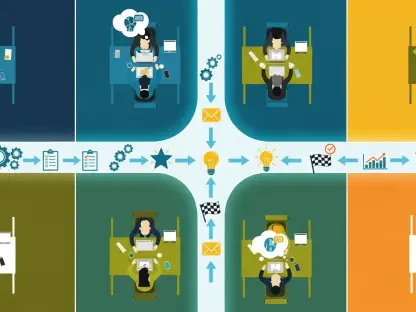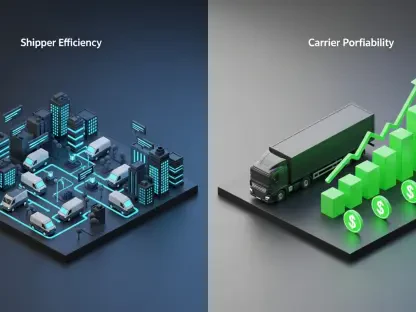In a world where rapid change has become a constant, HR professionals are confronted with the challenge of maintaining organizational resilience amidst perpetual shifts in the economic, technological, and social landscapes. The article, written by seasoned HR advisor Mark Stelzner, delves into the intricacies of this new normal and offers valuable insights into how HR leaders can navigate continuous change effectively.
Embracing Endless Change
Pivoting as a Permanent Strategy
The concept of the “pivot,” which gained traction in 2020 as organizations adapted to the unprecedented disruptions, has now solidified into a permanent strategic approach for HR leaders. This shift signifies an acknowledgment that change is no longer a temporary hurdle but an ongoing reality integral to the organizational fabric. As continuous evolution becomes the norm, HR leaders are compelled to integrate flexibility and adaptability into their core strategies, ensuring that their organizations can withstand the relentless pace of transformation.
This pervasive state of flux extends to various domains, including advancements in technology, evolving skill requirements, and shifts in workforce expectations. The ability to pivot has become synonymous with resilience, as organizations must swiftly recalibrate their operations, talent management practices, and strategic objectives to remain competitive. By embedding pivoting as a permanent strategy, HR leaders can foster a culture of innovation, agility, and preparedness, transforming challenges into opportunities for growth and development.
Big, Messy Questions
HR leaders today are navigating a labyrinth of complex and often contradictory questions that demand nuanced and strategic responses. The future of hybrid work presents one such conundrum. Balancing the benefits of flexible work arrangements with the need for collaboration and cohesive corporate culture requires deft maneuvering. Moreover, simultaneous challenges like managing hiring freezes, layoffs, and expansions necessitate a dynamic approach to workforce planning and talent acquisition.
In addition to these operational concerns, HR leaders must also devise strategies to lead effectively in an environment marked by ceaseless change. This entails fostering resilience and adaptability within teams, cultivating leadership skills that are suited to navigating ambiguity, and creating frameworks that support continuous learning and growth. Addressing these big, messy questions requires a holistic understanding of the interconnected factors influencing organizational dynamics and a commitment to innovative problem-solving.
Building Organizational Agility
Smart Systems Design
The hallmark of an effective organization in an era of constant change is its ability to design intelligent systems that anticipate and manage disruptions rather than merely reacting to them. This advanced approach involves creating “bridge frameworks,” which serve as temporary structures with predetermined expiration dates and decision points. These frameworks afford organizations the flexibility to stabilize and adapt without committing to rigid long-term solutions prematurely.
By integrating these smart systems, organizations can place a deliberate pause between reaction and redesign, allowing for more thoughtful and strategic decision-making. These systems empower HR leaders to balance immediate operational needs with long-term strategic objectives, ensuring that the organization remains agile and responsive to evolving circumstances. The ability to design and implement such systems is crucial for building sustained organizational agility and resilience.
Resilience Over Stability
The paradigm of transformation has fundamentally shifted from being a one-time event to a continuous process that necessitates perpetual adaptation and reinvention. In this new reality, stability is no longer the objective, but rather the exception. Successful organizations focus on cultivating resilience—the capacity to absorb shocks, adapt quickly, and emerge stronger from disruptions.
This resilience-centric approach requires a fundamental rethinking of traditional organizational models and structures. For HR leaders, this means fostering a culture that embraces change, encourages experimentation, and supports ongoing learning and development. By prioritizing resilience over stability, organizations can create an environment where innovation thrives, and employees are empowered to navigate the complexities of the modern business landscape.
Addressing the Human Impact
Burnout and Adaptation Exhaustion
Continuous change, while essential for organizational survival, exacts a significant toll on employees, leading to burnout and adaptation exhaustion. The relentless pace of transformation can overwhelm individuals, particularly those in younger generations who may experience higher rates of burnout. This phenomenon not only affects individual well-being but also impacts overall employee engagement, productivity, and retention.
To mitigate these effects, HR leaders must prioritize mental health and well-being initiatives, recognizing that a resilient workforce is one that is supported both professionally and personally. Strategies such as providing access to mental health resources, promoting work-life balance, and fostering a supportive organizational culture are critical in addressing burnout and ensuring that employees remain engaged and productive amidst continuous change.
Psychological Safety
Creating an environment of psychological safety is paramount in redefining stability within organizations. Employees need to feel secure in expressing concerns, sharing ideas, and navigating changes without fear of retribution or judgment. Psychological safety enables individuals to cope with ongoing disruptions more effectively, fostering a culture of trust, collaboration, and innovation.
HR leaders can cultivate psychological safety by promoting open communication, involving employees in decision-making processes, and demonstrating empathy and understanding in leadership practices. By prioritizing psychological safety, organizations can create a supportive environment where employees are empowered to contribute their best, adapt to changes, and maintain productivity even in tumultuous times.
Strategic Traits for HR Success
Continuous Learning Ecosystems
In an era of constant change, building continuous learning ecosystems is crucial for organizational success. These ecosystems emphasize ongoing education and skill development, enabling employees to adapt to evolving demands and challenges. Organizations that invest in continuous learning foster a culture of perpetual improvement, innovation, and adaptability.
HR leaders can facilitate continuous learning by providing access to diverse training programs, encouraging cross-functional knowledge sharing, and supporting career development initiatives. By cultivating a learning-driven environment, organizations empower employees to acquire new skills, stay relevant in their roles, and contribute to the organization’s long-term resilience and growth.
Transparency as an Advantage
Transparency in organizational communication is a powerful lever for building trust and fostering collaboration. By openly sharing challenges, progress, and decision-making processes, HR leaders can create a culture of trust and inclusion. Involving employees in problem-solving not only enhances engagement but also leverages diverse perspectives to generate innovative solutions.
Transparency becomes a competitive advantage when employees feel informed and valued, leading to higher levels of commitment and alignment with organizational goals. HR leaders can champion transparency by promoting regular communication, providing forums for feedback, and ensuring that information flows freely across all levels of the organization. This approach cultivates a sense of unity and shared purpose, driving organizational resilience and success.
Reimagining Career Development
From Career Ladders to Constellations
The traditional concept of linear career ladders is being replaced with “career constellations,” which offer more flexible and personalized pathways for professional growth. This shift recognizes that career development is not a one-size-fits-all journey, and individuals have diverse aspirations and strengths. Career constellations allow employees to explore different roles, gain varied experiences, and build a unique career trajectory that aligns with their interests and goals.
HR leaders can support this reimagined approach to career development by providing resources for skill development, offering mentorship programs, and facilitating cross-functional mobility. By embracing career constellations, organizations can attract and retain top talent, enhance employee engagement, and foster a dynamic and innovative workforce.
Employee Engagement and Well-being
In today’s world, where rapid change is a constant, HR professionals often face the tough task of preserving organizational resilience amid continuous flux in economic, technological, and social realms. The seasoned HR advisor Mark Stelzner authored an insightful article that explores the complexities of this new normal. Stelzner’s piece goes deep into how HR leaders can effectively navigate constant change while ensuring their organizations stay strong and adaptive. He discusses tactics for managing dynamic shifts and maintaining a robust, agile workforce that can handle unexpected challenges. Stelzner emphasizes the importance of strategic planning and proactive measures, including adopting new technologies and fostering a culture of continuous learning. By leveraging these approaches, HR professionals can lead their organizations through the unpredictable tides of change, ensuring long-term success and stability. This article serves as a valuable resource for HR leaders striving to stay ahead in a world where the only certainty is change.









